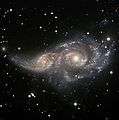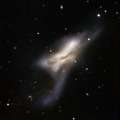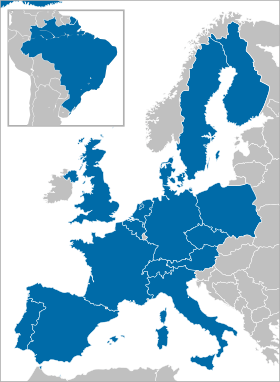ESO 3.6 m Telescope
 | |
| Organisation | European Southern Observatory |
|---|---|
| Location(s) | La Silla Observatory, Chile |
| Coordinates | 70° 43' 54.1" W -29° 15' 39.5" S (WGS84) |
| Altitude | 2,400 metres (7,900 ft) |
| Wavelength | Visible/Near IR |
| Built |
1976 first light 1977 full operations[2] |
| First light | 1977 |
| Diameter | 3.566 m (140″) |
| Angular resolution | 0.2 arc seconds at Zenith |
| Collecting area | 8.8564 m2 |
| Focal length | f/8 (HARPS) |
| Mounting | Equatorial/Horseshoe |
| Website | ESO 3.6m |
The ESO 3.6 m Telescope is an optical reflecting telescope run by the European Southern Observatory at La Silla Observatory, Chile since 1977, with a clear aperture of about 3.6 metres (140 in) and 8.6 m2 (93 sq ft) area.
The telescopes uses the HARPS instrument and has discovered more than 130 exoplanets. In 2012, it discovered Alpha Centauri Bb, a possible planet in the Alpha Centauri system only 4.4 light-years away.[3]
It received an overhaul in 1999 and a new secondary in 2004. When completed in the late 1970s, it was one of the world's largest optical telescopes. The ESO 3.6-metre Telescope has supported many scientific achievements and presented ADONIS, one of the first adaptive optics system available to the astronomical community in the 1980s.
Instruments
Since April 2008, the only instrument on the ESO 3.6 m telescope is HARPS, the High Accuracy Radial Velocity Planet Searcher. HARPS is a fibre-fed high resolution echelle spectrograph dedicated to the discovery of extrasolar planets. Other instruments on the telescope, now decommissioned, include:[4]
- CES: is a spectrograph that provides a resolving power of up to 235,000 in the 346–1028 nm region.
- EFOSC2: the ESO Faint Object Spectrograph and Camera (v.2), is a very versatile instrument for low resolution spectroscopy and imaging.
- TIMMI-2: the Thermal Infrared MultiMode Instrument dedicated to the 3–25 µm spectrum.
- ADONIS: is the acronym for Adaptive Optics Near Infrared System, and was a second-generation adaptive optics system for the astronomical community.[5] More than 40 peer-reviewed scientific articles were published based on this instrument data.[6] ADONIS is the final version of diverse Adaptive Optics (AO) prototypes named Come-on and Come-on +. It was offered in its final version in October 1996 as an official ESO instrument,[7] then decommissioned in 2001. ADONIS was the first AO system offered to a large community of astronomers.
Recent scientific achievements

The ESO 3.6 m telescope has made several scientific discoveries since it saw first light. Recent astronomical achievements were made possible by HARPS, a "top-class" instrument. This include finding the lightest exoplanet known at the time of discovery in, Gliese 581e, with only twice the mass of the Earth,[8] and the richest planetary system known at the time, with up to seven planets orbiting a Sun-like star.[9]
The telescope was also involved in solving a decades-old mystery regarding the mass of Cepheid variable stars. By using the HARPS instrument, astronomers detected for the first time a double star where a pulsating Cepheid variable and another star pass in front of one another, which allows to measure the mass of the Cepheid. The study concluded that the mass prediction coming from the theory of stellar pulsation was correct while the value calculated was at odds with the theory of stellar evolution.[10]
The discovery of the extrasolar planet Gliese 581 c by the team of Stéphane Udry at University of Geneva's Observatory in Switzerland was announced on April 24, 2007.[11] The team used the telescope's HARPS spectrograph, and employed the radial velocity technique to identify the planet's influence on the star.[11][12]
By 2009, the telescope was used to discover 75 exoplanet candidates.[13] In 2011, another 50 exoplanet candidates were announced.[14]
Contemporaries on commissioning
| # | Name (observatory) |
Image | Aperture | M1 area |
Altitude | First light |
Special advocate |
|---|---|---|---|---|---|---|---|
| 1. | BTA-6 (Special Astrophysical Obs) |
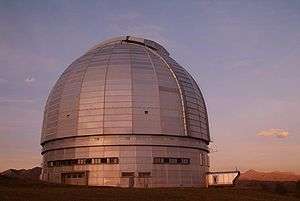 |
238 inch 605 cm |
26 m2 | 2,070 m (6,790 ft) | 1975 | Mstislav Keldysh |
| 2. | Hale Telescope (Palomar Observatory) |
 |
200 inch 508 cm |
20 m2 | 1,713 m (5,620 ft) | 1949 | George Ellery Hale |
| 3. | Mayall Telescope (Kitt Peak National Obs.) |
|
158 inch 401 cm |
10 m2 | 2,120 m (6,960 ft) | 1973 | Nicholas Mayall |
| 4. | Víctor M. Blanco Telescope (CTIO Observatory) |
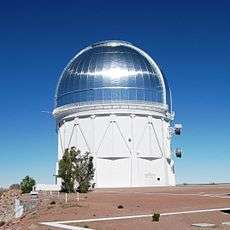 |
158 inch 401 cm |
10 m2 | 2,200 m (7,200 ft) | 1976 | Nicholas Mayall |
| 5. | Anglo-Australian Telescope (Siding Spring Observatory) |
|
153 inch 389 cm |
12 m2 | 1,742 m (5,715 ft) | 1974 | Prince Charles |
| 6. | ESO 3.6 m Telescope (La Silla Observatory) |
 |
140 inch 357 cm |
8.8 m2 | 2,400 m (7,900 ft) | 1976 | Adriaan Blaauw |
| 7. | Shane Telescope (Lick Observatory) |
|
120 inch 305 cm |
~7 m2 | 1,283 m (4,209 ft) | 1959 | Nicholas Mayall |
Gallery
Telescope and site
 The ESO 3.6-metre telescope.
The ESO 3.6-metre telescope. The road to the telescope at La Silla.
The road to the telescope at La Silla.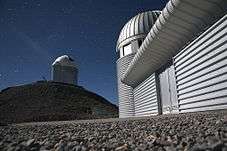 Euler Telescope and the ESO 3.6 m Telescope (background).
Euler Telescope and the ESO 3.6 m Telescope (background). Panoramic view of the ESO 3.6-metre telescope's dome.
Panoramic view of the ESO 3.6-metre telescope's dome. La Silla—Early evening scenery (in the distant right: the ESO 3.6 m T.)
La Silla—Early evening scenery (in the distant right: the ESO 3.6 m T.)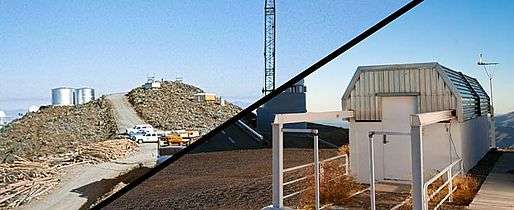 Construction of the ESO 3.6-metre telescope.[15]
Construction of the ESO 3.6-metre telescope.[15]
Images from telescope
See also
- List of largest optical reflecting telescopes
- List of largest optical telescopes in the 20th century
References
- ↑ The ESO 3.6 meter Telescope
- ↑ "Telescopes and Instrumentation, the ESO 3.6-metre Telescope" (Table on the right of the page). Retrieved 2011-05-02.
- ↑ http://www.planetary.org, Bruce Betts, B. Betts - First Planet Discovered in Alpha Centauri System - TPS, 18 October 2012
- ↑ "The ESO 3.6m Telescope". Retrieved 2011-05-26.
- ↑ Jack B. Zirker (2005). An acre of glass: a history and forecast of the telescope. JHU Press. p. 204. ISBN 978-0-8018-8234-0.
- ↑ ADS query results for "ADONIS"
- ↑ Gérard Rousset and Jean-Luc Beuzit (1999). "The COME-ON/ADONIS systems". In François Roddier. Adaptive optics in astronomy. Cambridge University Press. pp. 171 et seq. ISBN 978-0-521-55375-9.
- ↑ "Lightest exoplanet yet discovered". ESO. 2009-04-21. Retrieved 2011-05-26.
- ↑ "Richest Planetary System Discovered". ESO. 2010-08-24. Retrieved 2011-05-26.
- ↑ "Pulsating Star Mystery Solved". ESO. 2010-11-24. Retrieved 2011-05-26.
- 1 2 Than, Ker (2007-04-24). "Major Discovery: New Planet Could Harbor Water and Life". space.com. Retrieved 2007-04-29.
- ↑ Than, Ker (2007-02-24). "Planet Hunters Edge Closer to Their Holy Grail". space.com. Retrieved 2007-04-29.
- ↑ "32 planets discovered outside solar system - CNN.com". CNN. 19 October 2009. Retrieved 4 May 2010.
- ↑ 50 new exoplanets discovered by HARPS
- ↑ "Three Very Different Telescopes at La Silla". ESO Picture of the Week. Retrieved 8 May 2012.
External links
Coordinates: 29°15′40″S 70°43′54″W / 29.2610°S 70.7317°W
